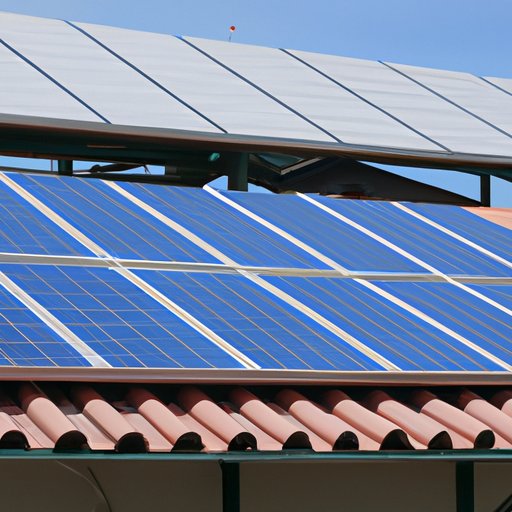Introduction
Solar panels are a great way to reduce your carbon footprint and save money on your energy bills. But before you invest in a solar energy system, it’s important to understand how many solar panels you can fit on your roof. In this article, we’ll explore how to calculate the number of solar panels that will fit on your roof, and discuss the environmental and financial benefits of investing in a solar energy system.

A Guide to Calculating How Many Solar Panels You Can Fit On Your Roof
Before you can determine how many solar panels you can fit on your roof, you need to estimate the size of your roof. This can be done by measuring the length and width of all sections of your roof that are suitable for solar panel installation. Once you have the measurements, multiply the length and width together to get the total square footage of each area. Add up the total square footage of all areas to get the total square footage of your roof.
Once you know the size of your roof, you can then determine how many solar panels you can fit on it. Generally speaking, a standard residential solar panel is approximately 5 feet by 3 feet and produces around 350 watts of electricity. To calculate the number of solar panels you can fit on your roof, divide the total square footage of your roof by the size of one solar panel (15 square feet). This will give you an approximate idea of how many solar panels you can fit on your roof.
When calculating the number of solar panels you can fit on your roof, it’s important to take into account local regulations and safety considerations. Some cities and towns may have restrictions on the number of solar panels that can be installed on a single residence. Additionally, you should make sure that the area where you plan to install the solar panels is strong enough to support the weight of the panels.
Exploring the Benefits of Installing Solar Panels On Your Roof
Installing solar panels on your roof has many benefits, both environmental and financial. When it comes to the environment, solar energy is a clean and renewable source of energy that doesn’t produce any harmful emissions or pollutants. By using solar energy instead of traditional fossil fuels, you can reduce your carbon footprint and help protect the planet.
From a financial perspective, investing in a solar energy system can help you save money on your energy bills. Depending on the size of your system and the amount of energy you use, you could potentially save hundreds of dollars each year. Additionally, some states offer tax credits and other incentives for homeowners who install solar panels.

How to Maximize Your Solar Panel Installation on Your Roof
To get the most out of your solar panel installation, it’s important to analyze the best orientation for your solar panels. Most solar panels work best when they’re facing south, as this allows them to capture the most sunlight throughout the day. If your roof isn’t oriented in the right direction, you may need to consider installing a tracking system that will adjust the angle of the panels to ensure they’re always facing the sun.
It’s also important to select the right type of solar panel for your needs. There are two main types of solar panels: monocrystalline and polycrystalline. Monocrystalline panels are more efficient, but they’re also more expensive. Polycrystalline panels are less efficient, but they’re cheaper. Depending on your budget and energy needs, you can choose the type of panel that’s best for you.

Considering the Impact of Roof Size and Shape When Installing Solar Panels
The size and shape of your roof can have a major impact on the number of solar panels you can fit on it. If your roof is small, you may not be able to fit as many panels as you’d like. On the other hand, if your roof is large, you may be able to fit more panels than you need. Additionally, the shape of your roof can affect the number of panels you can fit. For example, a flat roof may be able to accommodate more panels than a sloped roof.
A Step-by-Step Guide To Installing Solar Panels On Your Roof
Once you’ve calculated the number of solar panels you can fit on your roof, it’s time to start planning the installation process. The first step is to choose the right installer. Make sure to do your research and find a reputable installer with experience installing solar panels. Once you’ve chosen an installer, you should plan out the installation process and make sure that all necessary permits and approvals are obtained.
Finally, it’s time to execute the installation process. Your installer will come to your home and begin installing the solar panels. During this process, it’s important to follow all safety protocols and make sure that everything is properly installed and connected. Once the installation process is complete, you’ll be able to start enjoying the benefits of solar energy.
Conclusion
In this article, we explored how to calculate the number of solar panels you can fit on your roof, as well as the environmental and financial benefits of investing in a solar energy system. We also discussed how to maximize your solar panel installation and outlined the impact of roof size and shape when installing solar panels. Finally, we provided a step-by-step guide to installing solar panels on your roof. With this information, you can make an informed decision about whether or not to invest in a solar energy system.
(Note: Is this article not meeting your expectations? Do you have knowledge or insights to share? Unlock new opportunities and expand your reach by joining our authors team. Click Registration to join us and share your expertise with our readers.)
